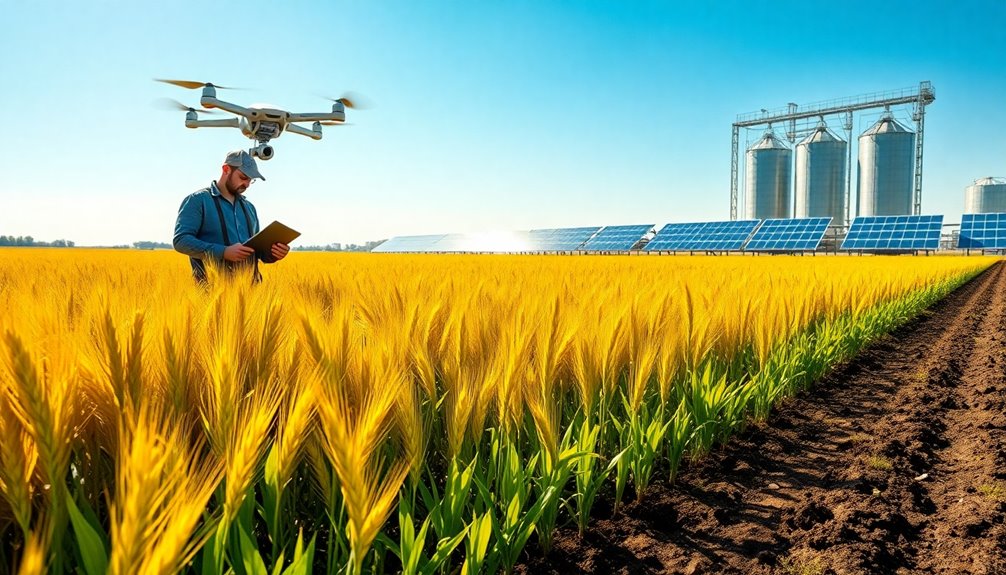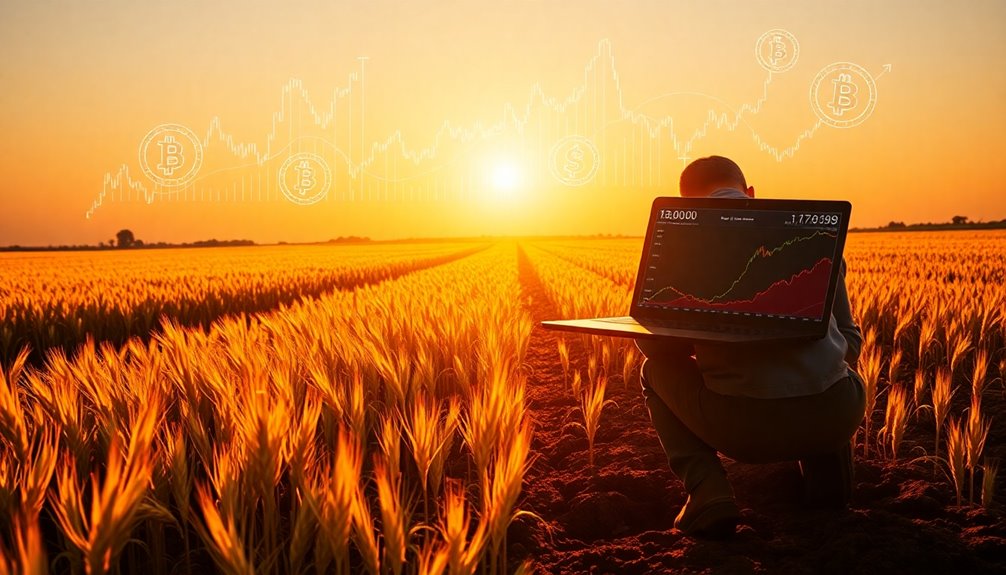Yield farming is a strategy where you earn passive income by lending or staking your cryptocurrency in liquidity pools. This practice first gained traction with decentralized lending platforms like Compound. You can receive rewards, often in the form of governance or native tokens, with annual yields sometimes exceeding 100%. However, be aware of risks like market volatility and potential losses due to impermanent factors. As the field evolves, trends like cross-chain farming and enhanced risk management tools are on the rise. To grasp more about the fascinating dynamics between agriculture and finance, keep exploring the latest developments.
Key Takeaways
- Yield farming in DeFi involves lending or staking crypto in liquidity pools to earn passive income through interest and rewards.
- APYs in yield farming can exceed 100%, offering high return potential, but they fluctuate based on market conditions.
- Risks include market volatility, smart contract vulnerabilities, and high transaction fees, which can significantly impact profits.
- Future trends indicate a shift towards cross-chain yield farming, enhanced risk management tools, and sustainable finance practices.
- Parallels exist between agriculture and finance, emphasizing the importance of diversity, sustainability, and effective resource allocation for optimizing returns.
Understanding Yield Farming

Have you ever wondered how you can make your cryptocurrency work for you? Yield farming is a decentralized finance (DeFi) strategy that lets you earn passive income by lending or staking your crypto assets in liquidity pools.
By providing liquidity to DeFi protocols, you can receive governance tokens or native tokens as rewards. This practice emerged with the Compound protocol, which pioneered earning interest through decentralized lending and borrowing.
Smart contracts play an essential role by automating transactions and ensuring transparency in the process. With annual percentage yields (APY) often exceeding 100%, yield farming presents an attractive opportunity for investors looking for better returns than traditional financial instruments, especially in a growing trading volume environment.
Mechanics of Yield Farming

Yield farming operates through a straightforward yet intricate process that involves depositing your cryptocurrencies into various decentralized finance (DeFi) protocols. By doing this, you can earn interest by participating in liquidity pools that facilitate trading on decentralized exchanges (DEXs).
Here's how it works:
- Smart Contracts: These automate transactions and define terms for liquidity provision, ensuring transparency.
- Tokens and Rewards: You earn native tokens as rewards, influenced by market dynamics and platform governance.
- Annual Percentage Yield (APY): Returns can be enticing, with APYs sometimes exceeding 100%, but they can fluctuate.
However, be mindful of impermanent loss, which can occur if the value of your deposited tokens changes relative to simply holding them.
Understanding these mechanics is vital in the yield farming landscape.
Risks and Challenges

Steering through the world of yield farming comes with its share of risks and challenges that can catch even seasoned investors off guard.
One major concern is market volatility, where fluctuating prices can severely impact your returns. You'll also need to be wary of smart contract vulnerabilities, as bugs can lead to hacks, with over $1.6 billion stolen from DeFi users since January 2022.
Additionally, impermanent loss might occur if the value of your liquidity declines compared to just holding those digital assets.
Regulatory risks are evolving, potentially affecting your yield farming strategies. High transaction fees on networks like Ethereum can eat into profits, making participation expensive during peak trading activities.
Understanding these factors is essential for maneuvering the yield farming landscape.
Future Trends in Yield Farming

The landscape of yield farming is poised for significant evolution as it increasingly aligns with traditional finance systems.
As you explore the future trends, consider these key developments:
- Cross-Chain Yield Farming: Enhanced accessibility across blockchain networks will attract more yield farmers to DeFi, expanding participation.
- Risk Management Tools: These innovations will bolster investor protection, helping mitigate potential losses and stabilize high returns.
- Sustainable Finance Principles: A focus on ecological considerations will reshape token distribution and encourage projects prioritizing long-term viability.
As the market matures, you'll likely see stabilization in yields, making yield farming more appealing to conservative investors.
Ultimately, these trends signify a shift toward a more secure and responsible approach to decentralized finance.
Comparing Agriculture and Finance

As decentralized finance continues to mature, parallels between agriculture and finance become increasingly clear. Just like farmers cultivate crops, you engage in yield farming to harvest returns from liquidity pools. Both fields require careful analysis of conditions—farmers observe weather and market prices, while you navigate market volatility and smart contract vulnerabilities.
| Agriculture | Finance | Similarities |
|---|---|---|
| Crop variety affects yield | Diversity of liquidity pools impacts returns | Both require strategic diversity |
| Sustainability is key | Adaptation to regulations is essential | Long-term viability is critical |
| Environmental risks present | Market risks and impermanent loss | Risk management is important |
In both agriculture and DeFi, optimizing for sustainability helps guarantee future success in the ever-evolving cryptocurrency markets. Additionally, understanding the importance of budgeting allows you to allocate resources effectively, ensuring you can weather financial storms just as farmers prepare for seasonal changes.
Frequently Asked Questions
What Does Yield Farming Mean?
Yield farming means using your cryptocurrencies to earn rewards by lending or staking them in liquidity pools.
When you deposit your crypto assets into smart contracts on decentralized finance platforms, you can earn interest in the form of native tokens.
While it offers potentially high returns, it also comes with risks like market volatility and smart contract issues.
How to Make Money Yield Farming?
Did you know some yield farming strategies can promise returns exceeding 400%?
To make money yield farming, start by providing liquidity to DeFi protocols with high annual percentage yields (APY).
Keep an eye on different platforms and chase the best rates.
You can also leverage your liquidity provider (LP) tokens in other pools to earn extra interest.
Just remember, thorough research and market tracking are essential to managing risks and maximizing your profits.
What Are the Risks of Yield Farming?
When you consider yield farming, you should be aware of several risks.
Market volatility can cause your investments to fluctuate wildly, leading to unpredictable returns.
You also face potential smart contract vulnerabilities, which have resulted in significant losses for many.
Impermanent loss can diminish the value of your assets compared to just holding them.
Plus, high transaction fees can eat into your profits, complicating your investment decisions.
Always weigh these risks carefully!
What Is the Primary Goal of Yield Farming in Defi?
When you plunge into the world of yield farming, you're not just chasing returns; you're on a quest for financial glory!
The primary goal is to maximize your cryptocurrency assets' returns by providing liquidity to decentralized protocols. By depositing your assets into liquidity pools, you earn rewards, often in the form of native tokens.
This strategy lets you harness the power of compounding, allowing your earnings to grow exponentially over time.
Conclusion
So, you've dived into yield farming, where you can grow your crypto wealth faster than you can say "blockchain." Just remember, while you're planting those digital seeds, there's always a chance a financial frost might nip at your profits. But hey, who needs a stable garden when you can gamble on the wild west of finance? After all, what's life without a little risk? Grab your virtual pitchfork, and let's hope for a bountiful harvest!










